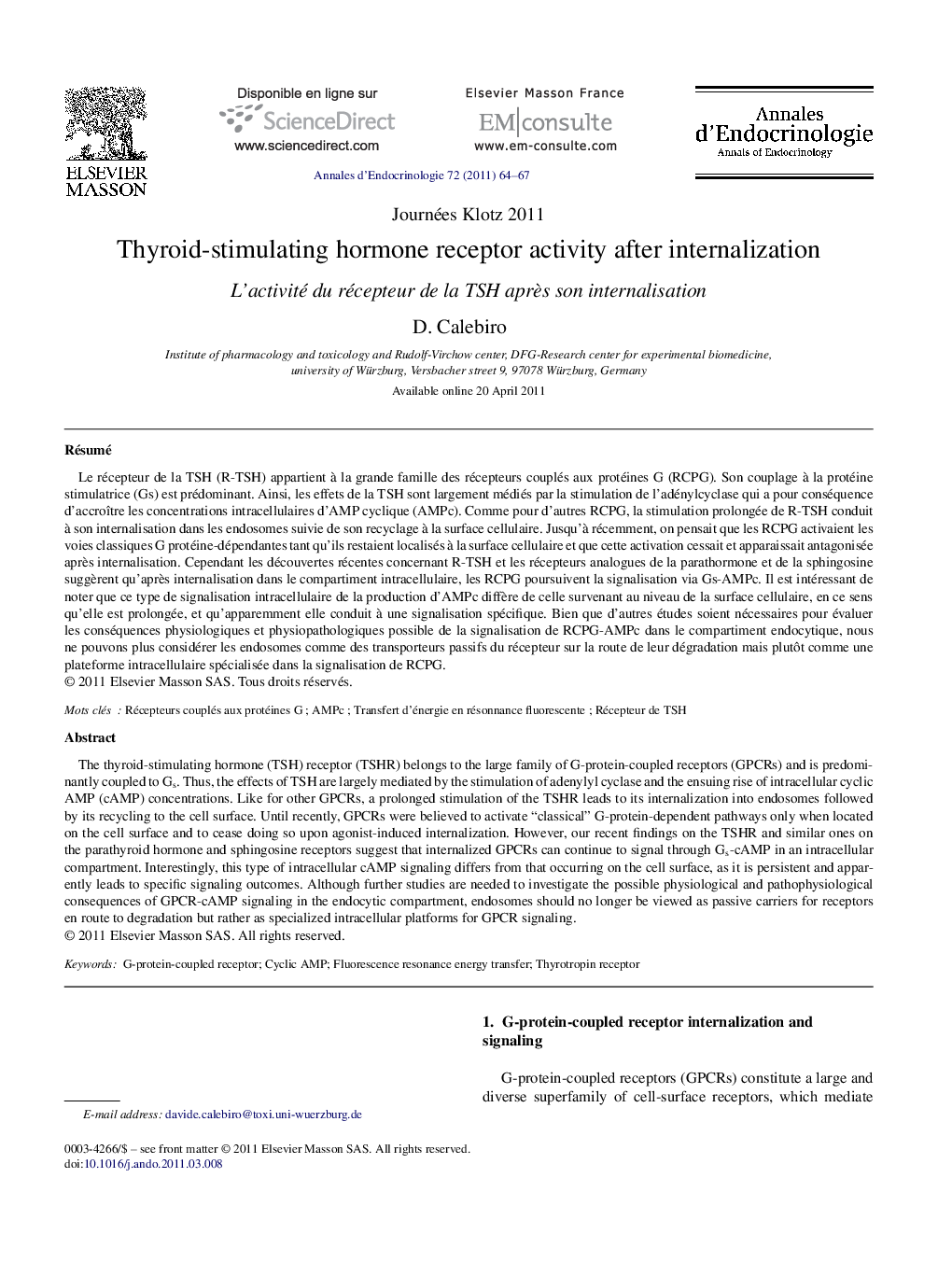| کد مقاله | کد نشریه | سال انتشار | مقاله انگلیسی | نسخه تمام متن |
|---|---|---|---|---|
| 3252813 | 1207081 | 2011 | 4 صفحه PDF | دانلود رایگان |

RésuméLe récepteur de la TSH (R-TSH) appartient à la grande famille des récepteurs couplés aux protéines G (RCPG). Son couplage à la protéine stimulatrice (Gs) est prédominant. Ainsi, les effets de la TSH sont largement médiés par la stimulation de l’adénylcyclase qui a pour conséquence d’accroître les concentrations intracellulaires d’AMP cyclique (AMPc). Comme pour d’autres RCPG, la stimulation prolongée de R-TSH conduit à son internalisation dans les endosomes suivie de son recyclage à la surface cellulaire. Jusqu’à récemment, on pensait que les RCPG activaient les voies classiques G protéine-dépendantes tant qu’ils restaient localisés à la surface cellulaire et que cette activation cessait et apparaissait antagonisée après internalisation. Cependant les découvertes récentes concernant R-TSH et les récepteurs analogues de la parathormone et de la sphingosine suggèrent qu’après internalisation dans le compartiment intracellulaire, les RCPG poursuivent la signalisation via Gs-AMPc. Il est intéressant de noter que ce type de signalisation intracellulaire de la production d’AMPc diffère de celle survenant au niveau de la surface cellulaire, en ce sens qu’elle est prolongée, et qu’apparemment elle conduit à une signalisation spécifique. Bien que d’autres études soient nécessaires pour évaluer les conséquences physiologiques et physiopathologiques possible de la signalisation de RCPG-AMPc dans le compartiment endocytique, nous ne pouvons plus considérer les endosomes comme des transporteurs passifs du récepteur sur la route de leur dégradation mais plutôt comme une plateforme intracellulaire spécialisée dans la signalisation de RCPG.
The thyroid-stimulating hormone (TSH) receptor (TSHR) belongs to the large family of G-protein-coupled receptors (GPCRs) and is predominantly coupled to Gs. Thus, the effects of TSH are largely mediated by the stimulation of adenylyl cyclase and the ensuing rise of intracellular cyclic AMP (cAMP) concentrations. Like for other GPCRs, a prolonged stimulation of the TSHR leads to its internalization into endosomes followed by its recycling to the cell surface. Until recently, GPCRs were believed to activate “classical” G-protein-dependent pathways only when located on the cell surface and to cease doing so upon agonist-induced internalization. However, our recent findings on the TSHR and similar ones on the parathyroid hormone and sphingosine receptors suggest that internalized GPCRs can continue to signal through Gs-cAMP in an intracellular compartment. Interestingly, this type of intracellular cAMP signaling differs from that occurring on the cell surface, as it is persistent and apparently leads to specific signaling outcomes. Although further studies are needed to investigate the possible physiological and pathophysiological consequences of GPCR-cAMP signaling in the endocytic compartment, endosomes should no longer be viewed as passive carriers for receptors en route to degradation but rather as specialized intracellular platforms for GPCR signaling.
Journal: Annales d'Endocrinologie - Volume 72, Issue 2, April 2011, Pages 64–67